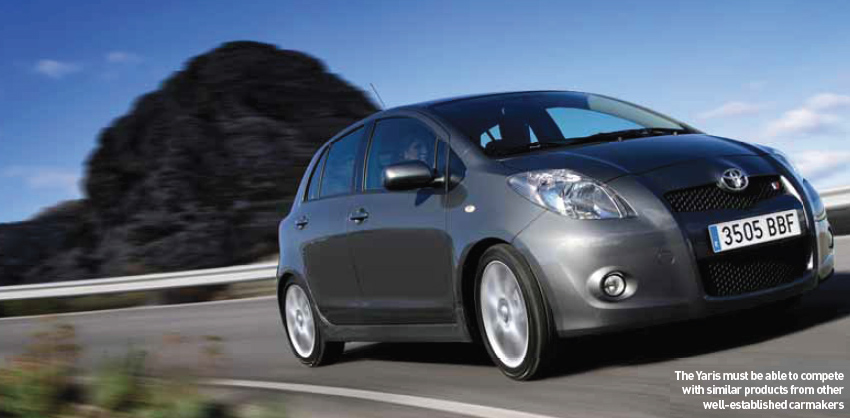
The Toyota Production System is a global success thanks to its customisation on a local level, and nowhere is this more evident than at the company’s Valenciennes plant in France. AMS talks to TMMF president Didier Leroy.
Europe currently ranks as number four in Toyota’s worldwide manufacturing league table. Its annual production of 800,000 units leaves it trailing Japan, North America and Asia, but the growth in the region – up from just 132,000 units ten years ago – makes it an important strategic location for the Japanese OEM.
Toyota first began selling cars in Europe under a distributor agreement in 1963, but since its move to the continent in the early 1990s, it has invested over €6 billion (US$9.3 billion) and currently employs almost 80,000 people. Its manufacturing operations are spread over eight locations, with a ninth in Russia coming online in the near future. The company’s two main car manufacturing locations are its Burnaston, UK facility, which produces 285,000 of the Avensis and Auris models annually, and at Valenciennes in France, where a variety of its Yaris models roll off the production line in similar quantities.
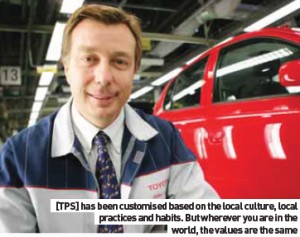 Localising TPS
Localising TPS
At the heart of Toyota’s success is its much-vaunted Toyota Production System (TPS), with its built-in quality controls and just-in-time supply chain. The roots of the system lie in Japan’s work environment and culture, so Toyota has had some problems establishing TPS in Europe and North America, but since it has been adapted to suit local requirements it has gone on to become a great success. “The Toyota Production System is not different in different parts of the globe,” Didier Leroy, President of Toyota Motor Manufacturing France, explains. “The way to make it easier to understand is that it has been customised based on the local culture, local practices and habits. But wherever you are in the world, the values are the same, the tools are the same. One of the main challenges for Toyota around the world is to keep Toyota in the DNA. “The way that the people can understand TPS and its values can be very different based on their history, culture or local habit. So it is important that each plant should develop its own management style. But the foundations are the same anywhere in the world.
“If you go to North America or Thailand or China or to the UK, Turkey or France, the same system is still there. There is no big difference in Toyota operating systems and what we call the Toyota way, the key values of Toyota. The way to explain to the members, the way to make these values key for them, which is typically the management style, can be different.
“When I joined Toyota one of the first pieces of advice given to me by the executive vice president of Toyota Motor Corporation was ‘please don’t just try to copy the way that Toyota in Japan is managing people. You should have a deep understanding of what the key values are, and you should have a deep understanding of what is here, and why our management system is so strong. Based on that you should establish your system based on the local people’.
“I will give you a very simple example. In many countries in North America and probably also sometimes in Europe, you don’t have, as we have in France, five strong unions, in the UK you have one union. You can decide to work with one union or another. In some other countries you have no union, but the French case is quite different. That means that we should adjust our way of management style for that relationship with unions. It doesn’t mean that it is more difficult or easier, it doesn’t mean that at all, but our management style should be adjusted according to the local conditions.”
European supply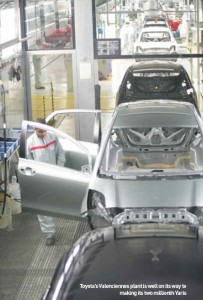
Toyota’s policy of manufacturing locally extends to the supply chain, and as Leroy explains, that translates to over 85 per cent of the value of the parts used in the Yaris being purchased within Europe. “We have something like 20 suppliers in Europe and we buy high-value parts there every year. In terms of part numbers we receive a lot of work in Japan, but it is mainly small parts. That means clearly that we are not working alone. It is the same in the UK, the same in Turkey – we produce the stamping, the welding and the paint shop. We have the assembly line, we have the plastic shop all internally; so yes, it is a fullyintegrated plant.”
The plant that Leroy is most familiar with is the Valenciennes facility, located north-east of Paris in the South Escout Valley. The 235-hectare site is home to Toyota’s most successful car, the Yaris. Towards the end of 2006, the plant celebrated the production of its millionth Yaris and, with an annual capacity of 270,000, is well on its way to its second million landmark.
“We have invested heavily at Valenciennes,” Leroy observes. “We did not say that we are building the Yaris here and as that is a small car, so we should have a correspondingly small investment.”
Lean production
“We are probably the leanest plant in the world for Toyota in terms of buffers between the welding shop, paint shop and assembly,” continues Leroy. “We have the shortest buffer internally for internal logistics. We continually push our lean production system to make sure we can be more efficient and achieve a better cost control for all different kinds of activity, which has two big advantages.
“Firstly, it allows more limited investments, not by deciding on cheap equipment, but by deciding to invest [in good equipment] only where it is required and can provide a benefit. The second point is to push us to have strict controls at each point of our quality process and to build in quality because in this kind of lean organisation, if you are not prepared to build in quality, the plants will be blocked very, very quickly; I would even say immediately. In this case we have no different back up solution. We should absolutely build in quality and our quality was very good from the first car we produced here.”
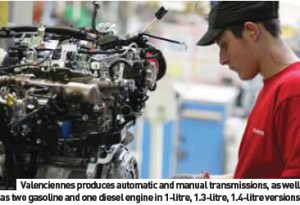 One model diversity
One model diversity
The fact that the seven-year-old facility is dedicated to just one model could be expected to return some advantage in terms of having to be less flexible than other multi-platform facilities. But as Leroy explains, any advantage to be gained through this is checked by the diversity that producing a model in Europe demands:
“It is true that we have an advantage in that we build a single model, whereas other plants have to produce a lot of different models. But in Europe it’s not true to say that it’s easier to produce just one model because there is more diversity in that one model here. In North America, for example, they have less diversity than us in terms of things such as right- and left-hand drive, which are really two different cars. They also have less diversity in terms of engine type. When you are in the US, engines are gasoline, transmission is automatic, cars are left-hand drive. In Europe you have right- and left-hand drive, automatic and manual transmissions, gasoline and diesel engines. These kinds of things are additional diversity, even if you have a single model.
“So it is a small advantage to have a single model, but please don’t forget that we produce right- and left-hand drive, automatic and manual transmission, 1-litre, 1.3-litre, 1.4-litre, two gasoline and one diesel engines. We have ten different colours that we produce for 24 different countries in Europe. If you mixed all the different options, the diversity is extensive. Also we have three- and five-doors, which adds further complexity. So we are very flexible. If we needed to, we could produce more than one car on the same line. We have very flexible equipment.”
• President, Toyota Motor Manufacturing France, Executive Vice President, Toyota Motor Europe, and Managing Offi cer Toyota Motor Corporation.
• Qualified as an engineer from the Ecole Supérieure des Sciences et Technologies de l’Ingenieur of Nancy in 1981.
• Began automotive industry career in 1982 with Renault and for over 16 years held a number of senior positions. In 1996, he was given responsibility for production of the Le Mans plant, becoming (at the time) the youngest deputy plant director of the Renault Group.
• He joined Toyota Motor Manufacturing France (TMMF) in September, 1998 as Vice President in charge of Manufacturing. In this role he took an active part in setting up the company’s European operations and constructing the Valenciennes plant, which began production in January 2001.
• In 2003, appointed Senior Vice President, responsible for overseeing the change in TMMF’s operations from two to three manufacturing shifts, further boosting production capacity.
• January, 2005 appointed President of Toyota Motor Manufacturing France – marking only the second time that a president of one of Toyota’s European plants was also a citizen of the plant’s host country.
• In addition to his role as president of TMMF, he was appointed a Managing Officer of Toyota Motor Corporation and an Executive Vice President of Toyota Motor Europe (TME) in June 2007. In his role as Executive Vice President of TME, he continues to focus on improving the operational efficiency of TME’s European manufacturing plants and support Toyota’s continued growth in Europe.
• Born in December 1957, he enjoys playing football, test-driving cars, jogging, skiing and river canyoning with his family. He is married with a son and a daughter.
Although the plant is currently working at near capacity, Leroy feels that slightly more could be achieved if needed, and was also happy to dispel the myth that the plant could only ever produce the Yaris, or a car of the same size. “Yes, in our plant if you asked us to produce a lot more cars tomorrow morning we would be in trouble and on the existing line we cannot produce very big cars. However, we have some margin and some flexibility. We can produce a car a little bit bigger than a Yaris. I do not have any clear data that I can give you about how long the car could be, but it is not a problem to produce a bigger car. It is true that we are limited in terms of some specific areas like the paint shop. We cannot have very big cars because of the shape and size, but we are not limited to making only the Yaris or smaller cars. We can produce a car slightly bigger than Yaris.”
Focus on the local
Despite a plant being constructed in Russia, and existing plants in Poland and the Czech Republic, Toyota remains committed to manufacturing in Western Europe. “For Toyota, the main point is to produce locally,” Leroy explains. “At the current exchange rate between the Yen, Euro and Pound, we could export a percentage of the cars from Japan into Europe if we wanted to, but it is not the Toyota strategy for the long term.
“For years now we have produced locally. Locally means that in the east of Europe we have to produce for the eastern European market. It is what we will be doing soon when we start production at the new Russian plant by the end of December (2008) – it will be local production for local markets and basically we produce in western Europe for the Western European market.
“This isn’t a specific handicap, but it is an additional challenge. Many of our competitors [avoid] that challenge and produce in low-cost countries. This is not our strategy. We want to locate our manufacturing facilities close to where we sell the cars, even if we are located in some specific area where the labour costs can be more expensive, like in some western European countries. “Location is not an excuse for a lack of competitiveness. We find a lot of ideas and solutions to develop competitiveness in our plants. One hundred per cent of the value of the car is not based on labour costs, so how can we make the entire global organisation competitive?”
Levels of automation
Where Toyota differs from some other automotive OEMs is that they do not slavishly follow the drive for high automation in their quest to combat high-wage costs. When the Valenciennes plant opened, it was considered as having a reasonably low density of robotics and automation. Leroy is happy to agree with that, pointing to the fact that, initially, there was a lack of key staff with enough experience and knowledge of modern automation to make it work successfully. “It was a slow process to train them step-bystep and develop them to make sure that they could control the high technology that was available,” he says. “Initially we began operating with an average labour to automation ratio – when we are talking about automation ratio we usually quote the figures for the bodyshop – of around 65 per cent, which is probably a little lower than the average ratio. Now we are between 70 and 75 per cent, so we have increased a little bit, but we are still not at a high automation ratio. “In the welding shop we have increased our number of robots by a little bit, we have something like 270 robots and our automation ratio is a little over 70 per cent. In there we have something called the global body line, which is the next generation of assembly body line. It’s a new concept in body assembly – we have the latest generation of Toyota equipment for that.
“In the paint shop we have robots for the external painting and clear coat, and of course for the primer and base coat. The change of colour is achieved using robot cartridges. This is Toyota’s latest technology. In the plastic shop we have the latest technology for our injection moulding press. So we have developed some top-class technology in our organisation.”
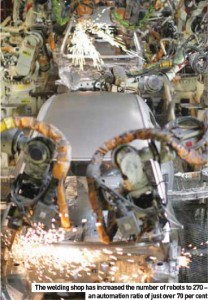 Environmental challenges
Environmental challenges
Leroy is quick to admit that competition is tough in Europe. It is full of well-established rivals, all with strong product ranges and it plies its trade in a mature market. “That means we have to ask ourselves how we can continue to grow in Europe.” Leroy says. “How can we continue to grow our business in Europe in profitable conditions? We have a lot of additional challenges there, such as some very challenging and specific targets for CO2, mandated by the European Community: 140g now and probably 120g later, and then probably less. This kind of target is a big challenge for every company and also for us in Europe.
“We fully respect this need because to respect the environmental aspect is really one of the key values of Toyota. Not only for car CO2 emissions but also for the plant. We constantly ask ourselves how we can produce cars with the lowest impact for the environment, as well as producing a car that is fully inline with the big challenge of CO2 emission reduction in Europe. This is currently one of the key aims for Toyota in Europe, which is first company to develop the right product, to become more self-reliant and that means making sure that we can, for the future, develop local products.”
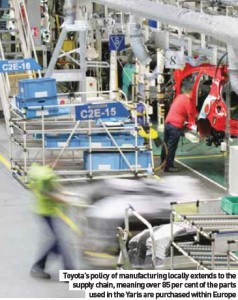 Design for the future
Design for the future
Given importance of the European market to Toyota, the regional research and development centre in Brussels, Belgium, will play a leading role in the design and development of the company’s new models. “Our design centre will become more and more powerful (in terms of) the designs for European products in the coming years,” says Leroy. “[This means] local production with local developments in Europe, specifically aimed at meeting local needs such as the EU targets on CO2 emissions.”
Leroy feels that Toyota’s ability to remain competitive in Europe is it’s greatest achievement. “Our best achievement in manufacturing is our capability to demonstrate that it is possible to succeed in Western Europe,” he says. “Globally, the automotive industry is decreasing, except for Toyota, which in itself presents another big challenge, as well as being a big success. So I would say that we fully respect the strategy and decisions of all of our competitors. But basically, through the development of the key values of the Toyota Production System, and also through our management and our capability to create and motivate our members, we are able to demonstrate that we can succeed everywhere in the world, including Western Europe; this is probably something that many of our competitors consider impossible.”
